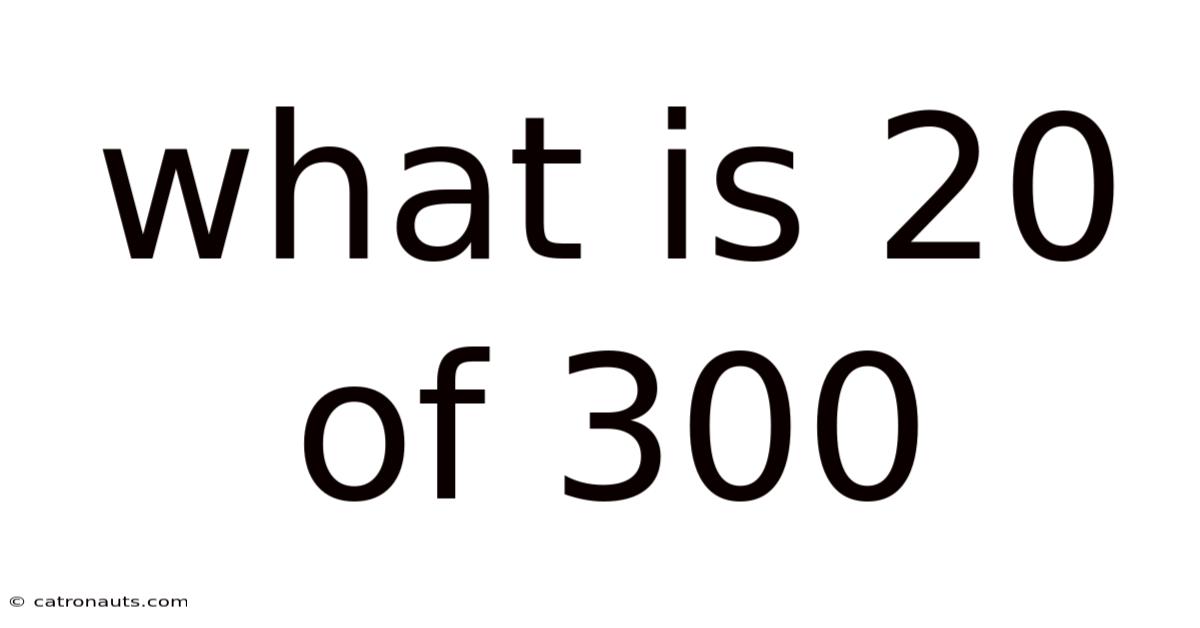What Is 20 Of 300
catronauts
Sep 14, 2025 · 4 min read

Table of Contents
What is 20 of 300? Understanding Percentages and Fractions
This article will explore the question "What is 20 of 300?" in depth, going beyond a simple numerical answer to provide a comprehensive understanding of percentages, fractions, and their applications in everyday life. We will cover various methods to calculate this, delve into the underlying mathematical concepts, and offer practical examples to solidify your understanding. This guide is suitable for anyone from students needing to grasp fundamental mathematical concepts to adults seeking to refresh their knowledge of ratios and proportions.
Introduction: Understanding Ratios and Proportions
The question "What is 20 of 300?" essentially asks us to determine the ratio of 20 to 300. A ratio is a comparison of two or more quantities. In this case, we're comparing 20 to 300. This ratio can be expressed in several ways: as a fraction (20/300), as a decimal, or as a percentage. Understanding ratios and proportions is crucial in various fields, from cooking and finance to science and engineering. They allow us to scale recipes, analyze financial data, and understand relative quantities.
Method 1: Calculating the Fraction
The most straightforward way to understand "20 of 300" is to represent it as a fraction. The phrase "20 of 300" directly translates to the fraction 20/300. This fraction represents the portion of 300 that is equal to 20.
To simplify this fraction, we find the greatest common divisor (GCD) of 20 and 300. The GCD is 20. Dividing both the numerator and the denominator by 20, we get:
20/300 = 1/15
Therefore, 20 is 1/15 of 300. This simplified fraction shows the relationship between 20 and 300 in its simplest form.
Method 2: Converting the Fraction to a Decimal
To convert the fraction 1/15 to a decimal, we divide the numerator (1) by the denominator (15):
1 ÷ 15 ≈ 0.0667
This decimal representation, approximately 0.0667, indicates that 20 represents approximately 0.0667 of 300.
Method 3: Calculating the Percentage
Percentages are a common way to express proportions. A percentage represents a fraction out of 100. To find the percentage that 20 represents of 300, we can use the following formula:
(Part / Whole) * 100%
In this case:
(20 / 300) * 100% = (1/15) * 100% ≈ 6.67%
Therefore, 20 is approximately 6.67% of 300. This means that if we divide 300 into 100 equal parts, 20 would occupy approximately 6.67 of those parts.
A Deeper Dive into Percentages: Practical Applications
Understanding percentages is essential for various real-world applications:
-
Financial Calculations: Interest rates, discounts, tax calculations, and profit margins are all expressed as percentages. Understanding percentages is critical for managing personal finances and making informed financial decisions.
-
Data Analysis: Percentages are frequently used to represent proportions in data analysis, allowing for easy comparison of different datasets. For example, understanding the percentage of students who passed an exam or the percentage change in a company's stock price.
-
Scientific Measurements: In scientific research, percentages are used to represent concentrations, error margins, and changes in quantities.
-
Everyday Life: Sales discounts (e.g., "20% off"), survey results, and nutritional information on food labels all utilize percentages.
Understanding Fractions: A Foundation of Mathematics
Fractions are a fundamental concept in mathematics. They represent parts of a whole. Understanding fractions is essential for:
-
Basic Arithmetic: Adding, subtracting, multiplying, and dividing fractions are essential arithmetic skills.
-
Algebra: Fractions are extensively used in algebraic equations and manipulations.
-
Geometry: Fractions are used to represent ratios of lengths, areas, and volumes in geometric figures.
-
Calculus: Fractions and their related concepts (like limits) are the foundation of calculus.
The Importance of Simplifying Fractions
Simplifying fractions, as we did with 20/300 to 1/15, makes them easier to understand and work with. A simplified fraction represents the same proportion in its most concise form. This simplification simplifies calculations and improves clarity.
Frequently Asked Questions (FAQ)
-
Q: Can I use a calculator to solve this? A: Yes, absolutely. A calculator can quickly perform the division (20/300) to get the decimal equivalent, and you can then multiply by 100 to find the percentage.
-
Q: Why is the percentage an approximation (6.67%)? A: Because the fraction 1/15 results in a repeating decimal (0.06666...). We round the decimal to a manageable number of decimal places for practical purposes.
-
Q: What if I wanted to find what percentage 300 is of 20? A: In this case, the calculation would be (300/20) * 100% = 1500%. This shows that 300 is 1500% of 20. It's important to carefully consider which number represents the "part" and which represents the "whole" in the percentage calculation.
Conclusion: Mastering Ratios, Fractions, and Percentages
This article has explored the question "What is 20 of 300?" in detail, demonstrating how to calculate the equivalent fraction (1/15), decimal (approximately 0.0667), and percentage (approximately 6.67%). We've also explored the underlying mathematical concepts of ratios, fractions, and percentages, highlighting their importance in various fields and everyday life. Mastering these fundamental mathematical concepts is key to developing a strong foundation in mathematics and problem-solving skills. Remember that understanding the relationships between fractions, decimals, and percentages allows for greater flexibility and deeper understanding of quantitative information. Practice these concepts, and you'll find them increasingly intuitive and useful in numerous contexts.
Latest Posts
Latest Posts
-
The Square Root Of 64
Sep 14, 2025
-
What Is 5 Of 20
Sep 14, 2025
-
What Is The Legal Framework
Sep 14, 2025
-
Things That Rhyme With Slow
Sep 14, 2025
-
Push And Pull Factors Australia
Sep 14, 2025
Related Post
Thank you for visiting our website which covers about What Is 20 Of 300 . We hope the information provided has been useful to you. Feel free to contact us if you have any questions or need further assistance. See you next time and don't miss to bookmark.